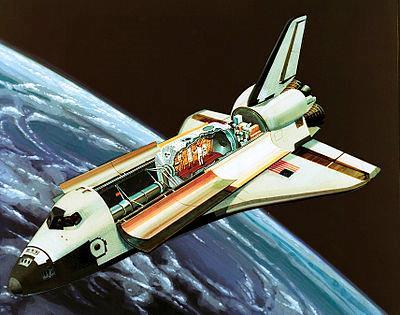Spacelab 026 - STS-75
Mission Name: N/A
Astronauts:
Command Pilot:
Andrew M. Allen
(Third Space Flight)
Pilot:
Scott J. Horowitz
(First Space Flight) Mission Specialist 1:
Jeffrey A. Hoffman
(Fifth Space Flight) Mission Specialist 2:
Maurizio Cheli,
ESA
(First Space Flight)
Mission Specialist 3:
Claude Nicollier,
ESA
(Third Space Flight) Mission Specialist 4:
Franklin R. Chang-Diaz
Payload Commander Mission Specialist 5:
Umberto Guidoni, ASI
(First Space Flight)
Spacelab was a reusable laboratory used on certain spaceflights flown by the Space Shuttle. The laboratory comprised multiple components, including a pressurized module, an unpressurized carrier and other related hardware housed in the Shuttle's cargo bay. The components were arranged in various configurations to meet the needs of each spaceflight.
Spacelab components flew on 22 Shuttle missions between November 1983 and April 1998. Spacelab allowed scientists to perform experiments in microgravity in Earth orbit.
Reflight of U.S./Italian Tethered Satellite System (TSS-1R) marred by loss of satellite on flight day three, although valuable scientific data was still gathered. Other primary payload, U.S. Microgravity Payload-3 (USMP-3), performed nominally. TSS considered primary payload at beginning of mission and USMP-3 primary following TSS operations.
TSS flew previously on Mission STS-46 in June 1992, but experiment operations curtailed due to jammed tether. TSS concept designed to study electrodynamics of a tether system in electrically charged portion of Earth's atmosphere called the ionosphere. Satellite provided by Italy and tether/deployer assembly U.S.-built. Twelve investigations -- six NASA, five Italian Space Agency (ASI) and one U.S. Air Force -- planned. Deployment of TSS-1R on STS-75 delayed one day to allow troubleshooting of onboard TSS computers by flight crew. Excellent scientific data was being gathered when tether snapped on flight day three as satellite was just short of full deployment of about 12.8 miles (20.6 kilometers). Satellite immediately began speeding away from orbiter as a result of orbital forces and the crew was never in any danger. Reason for tether break not immediately clear and investigative board convened on ground to determine cause. Crew retracted deployer and remaining tether following day.
Meanwhile, scientists did gather useful data from curtailed deployment. Currents measured during deployment phase were at least three times greater than predicted by analytical modeling, and amount of power generated was directly proportional to the current. Tether voltages of as high as 3,500 volts were developed across the tether, and current levels of about 480 milliamps were achieved. Researchers also able to study how gas from satellite's thrusters interacts with ionosphere. Also collected first-time measurements of ionized shock wave around the TSS satellite, a phenomenon that cannot be studied in the laboratory and is difficult to mathematically model. Another first was collection of data on the plasma wakes created by moving body through electrically-charged ionosphere. Some experiments conducted using free- flying satellite and attached tether before it re-entered Earth's atmosphere and broke up.
USMP-3, flying on shuttle for third time, included U.S. and international experiments, all of which had flown at least once before: Advanced Automated Directional Solidification Furnace (AADSF), a crystal growth facility; Critical Fluid Light Scattering Experiment (Zeno), to study element Xenon at its critical point; Isothermal Dendritic Growth Experiment (IDGE), to study formation of dendrites, tree-shaped crystals that in metals manufacturing dictate final properties of material; and Materials for the Study of Interesting Phenomena of Solidification on Earth and in Orbit (MEPHISTO) to study how metals solidify in microgravity using a furnace.
USMP-3 experiments conducted primarily through telescience, where principal investigators could control research from Marshall Space Flight Center's Spacelab Mission Operations Control Center. In MEPHISTO investigation, changes in microgravity environment caused by orbiter thruster firings were correlated with fluid flows in crystal sample. Also able to monitor point at which crystal sample underwent critical change during solidification process. Sample used was a tin-bismuth mixture representative of alloys found in airplane turbine blades, electronic materials and many other products.
In AADSF, three lead-tin-telluride crystals grown while orbiter flown at three different attitudes to determine effect on crystal growth. Also collected data on crystal’s freezing point. Lead-tin-telluride used in infrared detectors and lasers.
IDGE experiment yielded twice expected amount of data. Best images ever transmitted of dendrites were gathered. This also was first shuttle experiment controlled by principal investigator at a remote non-NASA site, foreshadowing types of research which will be conducted on International Space Station, where researchers could be based at universities.
Zeno allowed investigators to observe with unprecedented clarity behavior of xenon at critical point, when it exists as both gas and liquid. Such phase change phenomena common to many different materials and knowledge gained from Zeno could apply to such fields as liquid crystal growth and superconductor research.
Space Acceleration Measurement Systems (SAMS) and Orbital Acceleration Research Experiment (OARE), both of which have flown previously, provided data about on-orbit environment. In middeck, crew worked with Middeck Glovebox Facility (MGBX) featuring three combustion experiments, all of which were successful. Glovebox and Forced Flow Flamespreading Test experiment, both slated to fly on Russian Space Station Mir later this year, and glovebox also will fly on International Space Station. Also flying in middeck was Commercial Protein Crystal Growth (CPCG-09) experiment to process nine proteins into crystals to better understand their molecular structure.

(Fifth Space Flight)
Spacelab Space Missions
Study Research
Space Cosmology
Science Research
*
About
Science Research
Science Theories
Site Map
BookShelf
Desk
Copyright © by Nigel G Wilcox · All Rights reserved · E-Mail: ngwilcox100@gmail.com
Designed by Nigel G Wilcox
Powered By AM3L1A
Pages within this section: Spacelab 01-32
Spacelab C21-30
Sub-Menu
21
M
menu
22
23
24
25
26
27
8
29
30
28
>>>
D
SM









